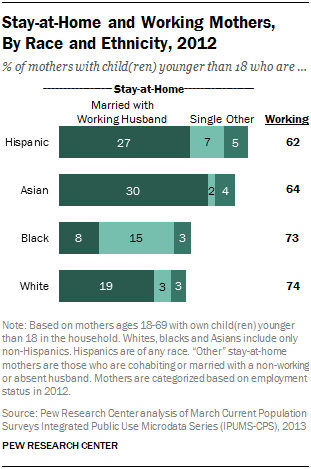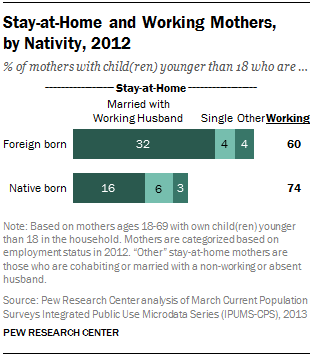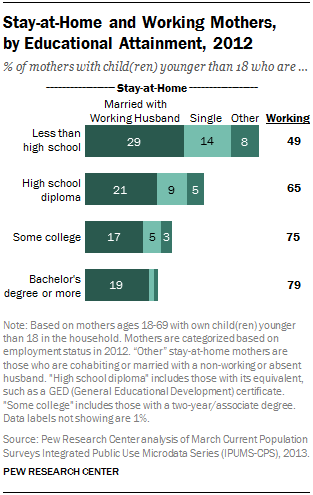There is substantial variation in the share of stay-at-home mothers among racial and ethnic groups and among mothers of different education levels. But the direction of change among all groups has been the same in recent years: The share of stay-at-home mothers has risen.
For all groups except Asians (whose data trail is shorter), the share of all stay-at-home mothers declined from 1970 to 2000 but rose somewhat from 2000 to 2012. For Asians, data began in 1987; the share of all Asian stay-at-home mothers rose from 2000 to 2012.
Racial and Ethnic Groups

Comparing racial and ethnic groups, Hispanic mothers (38% in 2012) and Asian mothers (36%) are most likely to be home with their children. Among white mothers, 26% were home with their children in 2012, as were 27% of black mothers.
The higher share of stay-at-home mothers among Hispanic and Asian women relates to the fact that so many are immigrants. Fully 86% of Asian mothers were born outside of the U.S., as were 60% of Hispanic mothers. In comparison, just 13% of black mothers and 6% of white mothers are foreign born. Among all immigrant mothers in 2012, 40% were stay-at-home mothers, compared with 26% of mothers born in the U.S.
Among stay-at-home mothers, the “traditional” married stay-at-home mother (with a working husband) is the most common type among Asians, whites and Hispanics. Black stay-at-home mothers are most likely to be single. The share of stay-at-home mothers has risen since 2000 for all four racial and ethnic groups, after declining in the years leading up to 2000. The rise from 2000 to 2012 was most striking for black mothers, whose stay-at-home share rose to 27% from 18%. For the period from 1970 to 2012, stay-at-home mothers declined as a share of all mothers for whites, blacks and Hispanics. Data for Asian stay-at-home mothers have been available since 1987; the share is about the same in both years.
Trends by Nativity

Foreign-born mothers are far more likely than U.S.-born mothers not to work outside the home. In 2012, 40% of immigrant mothers were stay-at-home mothers, compared with 26% of U.S.-born mothers. Immigrants also are more likely than U.S.-born mothers to be married stay-at-home mothers.
Trends in the share of stay-at-home mothers are similar for foreign-born and U.S.-born mothers since 1993, the first year for which data became available by nativity. The share of stay-at-home mothers declined for both groups for 1993-2000 and grew for 2000-2012, with an interruption for several years around the time of the Great Recession.
Educational Attainment

In terms of schooling, the least educated mothers are the most likely not to work outside the home. In 2012, 51% of mothers with less than a high school education were stay-at-home mothers, compared with 35% of high school graduates, 25% of mothers with some college education and 21% of college graduates. The least educated mothers are most likely to be stay-at-home single mothers.
Among stay-at-home mothers, the most educated mothers are the most likely to be married with a working husband (not shown in chart). Fully 88% of stay-at-home mothers with a college degree are married to a working husband. By contrast, among stay-at-home mothers with less than a high school diploma, only 57% are married with a working husband. The share is slightly higher for high school graduates who are stay-at-home mothers with a working husband (60%).
Only the least educated mothers are about as likely now as in 1970 to be stay-at-home mothers, though their share dipped in the late 1990s before rising again. Among women of other educational attainment groups, the share dipped until about 2000, when it began rising again, but it did not reach earlier levels. Among mothers with a college degree, the share of stay-at-home mothers grew only one percentage point, from 20% in 2000 to 21% in 2012.12




